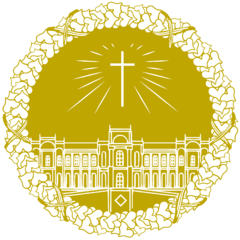Catholic Social Party (Werania)
Catholic Social Party Katholische Soziale Partei | |
|---|---|
 | |
| Abbreviation | KSP |
| Leader | Gustav de Maizière (first) Konstantin Vogel (last) |
| Founded | 7 March 1910 |
| Dissolved | 13 May 1957 |
| Merged into | National Consolidation Party |
| Headquarters | Westbrucken |
| Newspaper | Stimme des Volkes |
| Armed wing | Soldaten des Reichsbanners (unofficial) |
| Ideology | Political Catholicism Sotirian Democracy Social conservatism |
| Political position | Centre-right |
| Religion | Solarian Catholicism |
| Colours | Gold |
The Catholic Social Party (Weranian: Katholische Soziale Partei) was a political party in Werania that existed from its creation in 1910 to its dissolution in 1957 when it merged into the National Consolidation Party. Throughout its existence it was one of the main political parties in Werania and served in every government from 1914 to 1957 save from a four year period from 1918 to 1922.
The KSP was created in 1910 after electoral reform allowed a greater number of political parties to freely participate in Weranian elections that had a feasible chance of attaining seats in the Volkstag. Founded by priest Gustav de Maizière the KSP was the first attempt to create a mass-based political party on the right rather then the left as well as bring Sotirian democratic ideals to Werania rather then the traditional political forces of aristocratic conservatism, secular liberalism or revolutionary socialism. Its supporters were therefore found within the petite bourgeoisie and the traditionalist rural population.
The KSP first ran for the Volkstag in 1911 where it became the second largest force after the liberals. In the aftermath of the Great Collapse it entered government with the conservative and peasants parties under de Maizière; however it struggled to implement its political programme and was ousted from government in 1918 by the left-wing popular front between socialists and radicals. The KSP would sit in opposition until 1922 when the election that year produced the most divided legislature in Weranian history, with the far-right and socialists dominating. The KSP as the largest of the "constitutionalist" (i.e non-radical) parties became the largest party in the minority governments that governed in the leadup to the Great War (1922-1926). During the Great War the KSP was again the largest of the coalition parties that governed during that period with two KSP Chancellors - Reinhold von Schönborn-Herz and Otto Röttgen - governing in that period.
Following the Great War the KSP became the largest party in the Volkstag and led several centrist governments following the 1935 and 1938 elections. In 1942 however the right-wing Weranic Reich Party (ORP) became the largest in the Volkstag displacing the KSP. Although the KSP would continue to serve in government the 1942-1950 "national bloc" governments were far to the right of the party with the KSP being the more moderate voice in the national bloc governments.
In 1950 following the Colonels putsch and collapse of the national bloc governments the KSP became instrumental in the formalisation of the Tripartite governments between the Weranic Section of the Workers' International (OSAI) and Social Democratic Party of Werania (SPO). The Tripartite governments would oversee the expansion of the welfare state and the consolidation of a social market economy, the latter of which was keenly supported by the KSP who began to explicitly model themselves off the Gaullican Catholic Labour Union.
In 1955 KSP leader Konstantin Vogel withdrew the party from the Tripartite alliance and entered government with the Conservative Party and National Liberal Party. The three parties agreed to merge into a single centre-right party in 1957 which became named the National Consolidation Party (NKP) thus ending the KSP's existence. The NKP inherited the KSP's Sotirian democratic profile and for the majority of its existence the NKP has taken the strongest influence from the former KSP - only in 1983 with the election of a left-wing government did Werania for the first time since 1922 lack any ministers of a Sotirian democratic background.
History
Ideology
Election results
| Election | Volkstag | Rank | Government | Leader | ||||
|---|---|---|---|---|---|---|---|---|
| Votes | % | ±pp | Seats won | +/− | ||||
| 1911 | TBA | TBA% | New | 135 / 597
|
New | #2 | Opposition | Gustav de Maizière |
| 1914 | TBA | TBA% | TBA | 163 / 597
|
#1 | Coalition government | Gustav de Maizière | |
| 1918 | TBA | TBA% | TBA | 108 / 597
|
#2 | Opposition | Erich Schätzle | |
| 1922 | TBA | TBA% | TBA | 119 / 621
|
#3 | Coalition government | Gustav de Maizière | |
| 1935 | TBA | TBA% | TBA | 160 / 584
|
#1 | Coalition government | Otto Röttgen | |
| 1938 | TBA | TBA% | TBA | 164 / 584
|
#1 | Coalition government | Walther von Pittermann | |
| 1942 | TBA | TBA% | TBA | 106 / 621
|
#3 | Coalition government | Walther von Pittermann | |
| 1946 | TBA | TBA% | TBA | 118 / 597
|
#3 | Coalition government | Johannes von Günther | |
| 1950 | TBA | TBA% | TBA | 104 / 597
|
#2 | Coalition government | Johannes von Günther | |
| 1954 | TBA | TBA% | TBA | 108 / 586
|
#2 | Coalition government | Konstantin Vogel | |
| 1955 | TBA | TBA% | TBA | 174 / 586
|
#1 | Coalition government | Konstantin Vogel | |